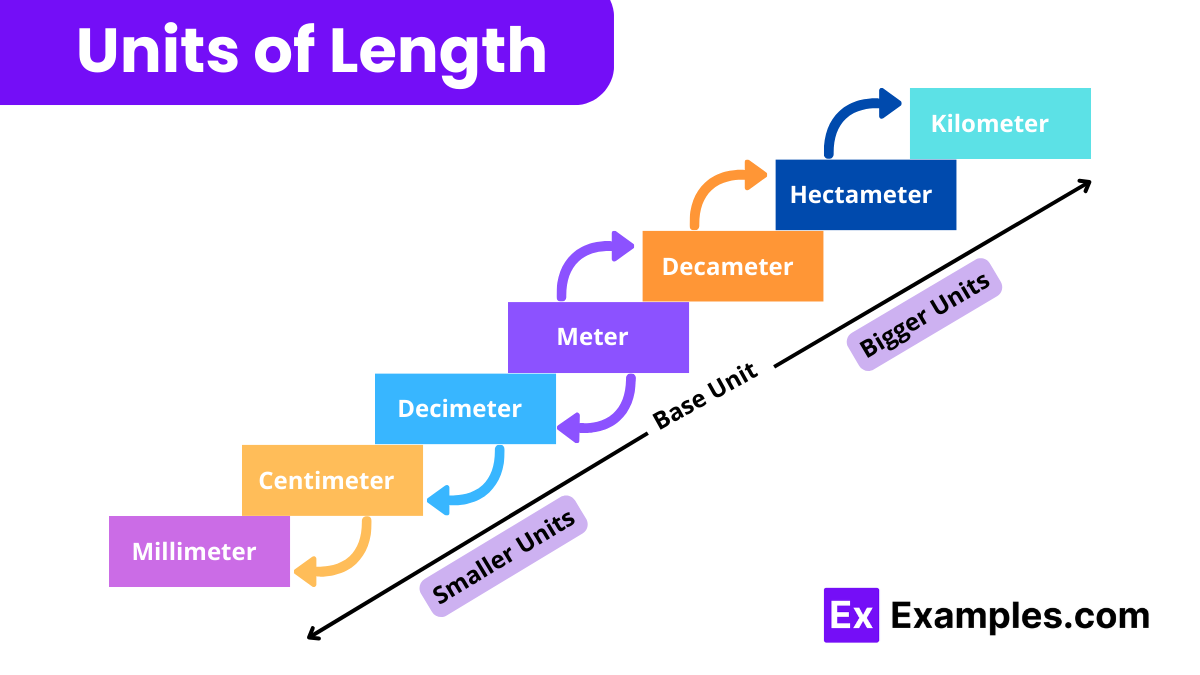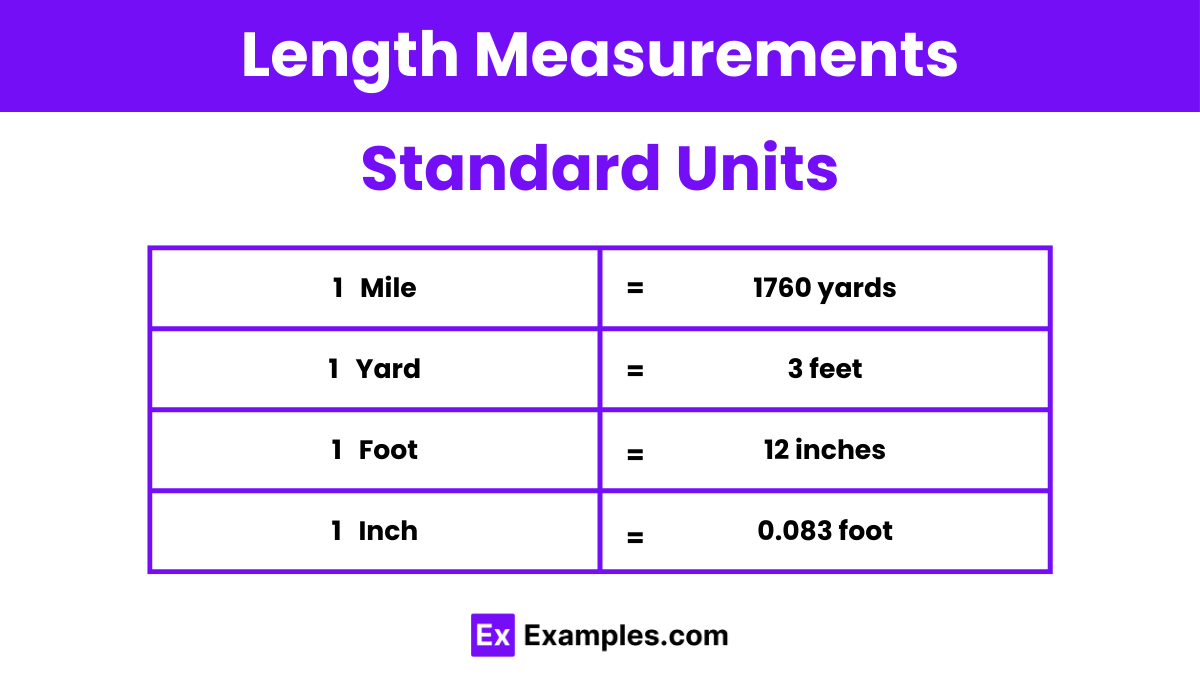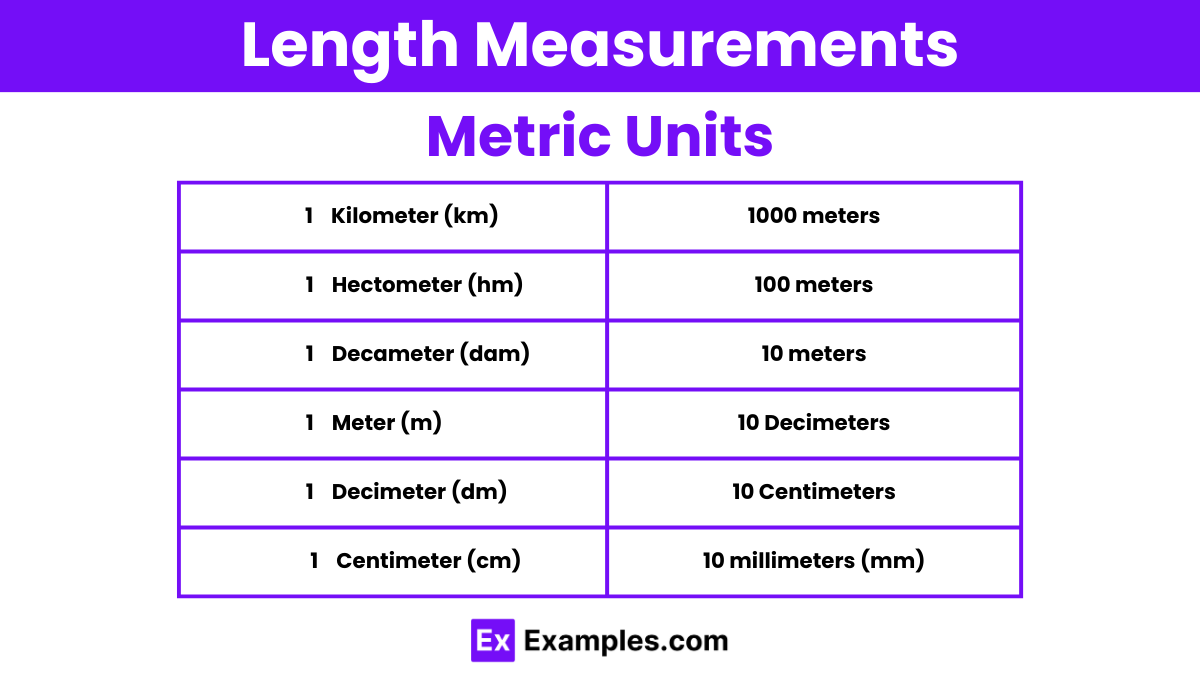What is the length of a rectangle if its perimeter is 30 cm and its width is 5 cm?
9 cm
10 cm
11 cm
12 cm

Measuring length helps us figure out how long or tall something is with tools like rulers and measuring tapes. It’s a handy skill used everywhere—from the classroom to construction sites. Some of the Regularly used length measuring units are centimeters, millimeters, meters, inches, feet, yards, feet, etc. We use them to describe length in ways that make sense for different tasks. Understanding how to measure length is crucial not only for school projects but also in everyday tasks and various professions. Let’s explore the simple yet vital world of length measurement, a fundamental skill that shapes our understanding of the spaces and objects around us.

Measuring how long something is can be done in different ways. We can use centimeters, inches, and meters, or even our hands and feet. There are two kinds of measuring units we talk about: Standard length measuring units and non-standard length measuring units

Standard units are the official measurements used all around the world. These include centimeters (cm), meters (m), and kilometers (km) from the metric system, and inches (in), feet (ft), and miles (mi) from the imperial system. Using standard units means everyone understands the exact size you’re talking about, whether you’re measuring the length of a new sofa or the distance to your friend’s house. It’s like a common language for sizes and distances. Standard units can again be divided into two types: Imperial units and metric system units.
Imperial Units
The British Imperial System is a set of measurements that were officially adopted in Britain through the Weights and Measures Acts of 1824 and 1878. These acts standardized measurements like inches, feet, and yards. Here’s a look at some of the key Imperial units:
| Imperial Unit | Equivalent in Imperial | Metric Equivalent |
|---|---|---|
| Nautical Mile | 1.151 miles | 1852 meters |
| Mile | 1760 yards | 1609 meters |
| Furlong | 220 yards | 201 meters |
| Rod | 5.5 yards | 5.029 meters |
| Fathom | 6 feet | 1.829 meters |
| Yard | 3 feet | 0.9144 meters |
| Feet | 12 inches | 0.3048 meters |
| Inch | 0.083 foot | 0.0254 meters |
Metric System

The metric system simplifies measurements of length using units like kilometers, meters, and millimeters. The meter is the fundamental unit, and other measures are scaled by powers of ten from it.
Non-standard units are more informal and can be anything around us that we use to measure length. Common examples include using the width of your hand (handspan), the size of your foot (foot length), or even a pencil. These units are handy when you don’t have a ruler or tape measure nearby, or when precision isn’t critical. For instance, you might use your feet to walk off the size of a rug. While non-standard units can vary from person to person, they’re still useful for getting a rough idea of size or distance.
The SI (International System of Units) unit of length is the meter (symbol: m). The meter is defined as the distance light travels in a vacuum in 1/299,792,458 of a second. The meter is the base unit of length.
Measurement of length is fundamental in various fields, such as construction, engineering, tailoring, and everyday activities. Understanding the tools used for measuring length helps in selecting the appropriate instrument based on accuracy, unit of measurement, and the object or distance being measured. Below, we explore some commonly used tools for length measurement, highlighting their applications and features.
A ruler is one of the most basic and widely used tools for measuring length. Typically made of wood, metal, or plastic, rulers are available in various sizes, with lengths of 6 inches (15 cm) and 12 inches (30 cm) being the most common. They are ideal for measuring short distances and are commonly used in schools, offices, and by DIY enthusiasts.
A tape measure is a flexible ruler used to measure size or distance. It consists of a ribbon of cloth, plastic, fibre glass, or metal strip with linear-measurement markings. Tape measures are commonly used in construction, architecture, and sewing. They are versatile and can measure round or curved surfaces, making them indispensable for tailors and carpenters.
Calipers are precision tools used to measure the distance between two opposite sides of an object. There are several types of calipers, including vernier, digital, and dial calipers, each providing different levels of accuracy. Calipers are essential in mechanical engineering, metalworking, and other fields where precise measurements are crucial.
A micrometer, also known as a micrometer screw gauge, is a device used for precision measurement of small distances. It offers higher accuracy than calipers, with the ability to measure thickness, diameters, and depths of objects. Micrometers are widely used in mechanical engineering, machining, and scientific research.
Laser measures are advanced tools that use laser technology to measure distances, areas, and volumes. They are highly accurate and can measure long distances with ease. Laser measures are beneficial in construction, real estate, and landscaping where traditional measuring tools may not be practical.
A yardstick is a long, flat measuring stick, typically 36 inches (1 yard) in length. It is used for measuring lengths and drawing straight lines on large surfaces. Yardsticks are common in tailoring, woodworking, and educational settings for measuring fabric, wood, and various project materials.
A measuring wheel, also known as a surveyor’s wheel, is used for measuring long distances by rolling it along the ground and counting the number of rotations, which corresponds to the distance traveled. It is commonly used in surveying, landscaping, and by law enforcement for accident scene measurements.
| 1 km | 1000 m |
| 1 m | 100 cm |
| 1 cm | 10 mm |
| 1 Nautical Mile | 1.151 miles |
| 1 Mile | 1760 yards |
| 1 Furlong | 220 yards |
| 1 Yard | 3 feets |
| 1 Foot | 12 inches |
| 1 Inch | 0.083 foot |
| Metric to Imperial System | 1 cm = 0.3937 inches1 m = 39.37 inches
1 m = 3.28 feet 1 km = 3280.84 feet 1 km = 0.62 miles 1 km = 1093.61 yards |
|---|---|
| Imperial to Metric System | 1 inch = 2.54 cm1 foot = 30.48 cm
1 yard = 91.44 cm 1 foot = 0.3048 m 1 mile = 1.6 km 1 mile = 1609.34 m 1 yard = 0.9144 m |
Typically, length is mentioned before width when describing dimensions, adhering to the convention of “length by width” for measurements of objects or areas.
One inch is exactly equal to 2.54 centimeters. This conversion is fundamental in measurements, allowing for precise transitions between the imperial and metric systems.
A centimeter is a unit of length in the metric system, equal to one hundredth of a meter. It’s a common measure for everyday objects and distances.
Text prompt
Add Tone
10 Examples of Public speaking
20 Examples of Gas lighting
What is the length of a rectangle if its perimeter is 30 cm and its width is 5 cm?
9 cm
10 cm
11 cm
12 cm
If a rope is 8 meters long and is cut into 4 equal pieces, what is the length of each piece?
2 meters
1.5 meters
2.5 meters
3 meters
A piece of string is 60 cm long. If 20 cm is cut off, what is the remaining length of the string?
30 cm
40 cm
50 cm
60 cm
What is the perimeter of a square with each side measuring 7 cm?
28 cm
14 cm
21 cm
35 cm
A garden is 12 meters long and 5 meters wide. What is its area?
30 square meters
40 square meters
50 square meters
60 square meters
How many centimeters are in 3.5 meters?
350 cm
35 cm
3.5 cm
700 cm
If a rectangle’s length is twice its width and the width is 4 cm, what is the length?
6 cm
7 cm
8 cm
9 cm
A line segment is 15 cm long. If it is divided into 3 equal parts, what is the length of each part?
4 cm
5 cm
6 cm
7 cm
A rectangular pool is 25 meters long and 10 meters wide. What is the perimeter of the pool?
40 meters
50 meters
60 meters
70 meters
If a cylindrical can has a radius of 7 cm and a height of 15 cm, what is the circumference of the base?
44 cm
46 cm
48 cm
49 cm
Before you leave, take our quick quiz to enhance your learning!

